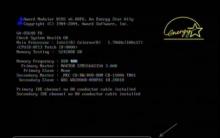Recently, laptop manufacturers have practically abandoned the pre-installation of Windows 7 and now it is almost impossible to buy a laptop with an OS that the user has just begun to like. All models have a new system, windows 8. But this fact is not to the liking of the buyer, and most Users REINSTALL this very windows 8, returning to Windows 7. And if it does not work out, they bring it to the service. So this article will focus on just such a case.
Given a new laptop Hp Pavilion 15-b052sr. Installed Windows 8. Computer characteristics:
Type - laptop, ultrabook. The installed operating system is Win 8 64. Processor - Core i3 1800 MHz. Chipset - Intel HM77. Memory - 4096 MB DDR3 (expandable up to 8192 MB). Screen - 15.6 inches, 1366x768, widescreen. Graphics chipset - NVIDIA GeForce GT 630M. Video Memory - 1024 MB GDDR3. Optical Drive - No DVD. The total amount of drives (HDD + SSD Cache) - 352 GB. The volume of the first drive (HDD) is 320 GB. SSD Cache capacity - 32 GB. Network card - 10/100 Mbit / s. Wireless communication - Bluetooth, Wi-Fi 802.11n. Interfaces - USB 2.0, USB 3.0x2, HDMI, mic./out. to headphones Combo, LAN (RJ-45). Additional information - SSD Cache disk.The task is to reinstall Windows 8 on Windows 7 on the HP Pavilion 15-b052sr laptop.
As we can see from the characteristics, there is NO optical drive. We take an external drive, plug it into the USB connector, go to the BIOS, and now please do everything that is described below carefully, otherwise the OS will not be installed, because when booting from the installation disk, Windows will not see any device, i.e. neither HDD nor external DVD.
So let's go, we set up the BIOS on the HP Pavilion 15-b052sr to install Windows 7.
1. Go to the BIOS by pressing the F10 button.
2. Go to the Intel (R) Rapid Storage Technology menu item, delete all Raid arrays, now we see that both disks and SSD and HDD are not in a ride (no-raid).
3. Switch the UEFI mode to Legacy mode.
4. Disable Security on disks and install Legacy.
5. The option to enable USB 3.0 mode is set to Auto, the default is Enable.
Save, reboot and install Windows 7 as usual.
With the advent of UEFI and the imposition of Windows 8 on everyone, by pre-installing it on most new laptops, installing Windows 7 on a laptop has acquired some nuances. Fortunately, you can still find drivers for the seven on many laptops. So today a patient HP Pavilion g6-1200er was delivered to change the operating system from Windows 8 to Windows 7.
So, installing Windows 7 on an HP Pavilion g6 laptop consists of the following steps:

In this menu we see that in order to enter BIOS need to press F10.
The required driver for the optical disc drive was not found
During installation, an error appears stating that “The required driver for the optical disc drive was not found. If you have a floppy disk, CD, DVD, or USB flash drive with this driver, please insert that media. Note: If the Windows installation media is inserted in the CD / DVD drive, you can remove it during this step. " 
It occurs due to the fact that we have installation media (in this case, the flash drive is inserted into USB 3.0), and Windows 7 does not support USB 3.0 out of the box... And we need to either insert the media into USB 2.0, or, as in this case, switch the operating mode to USB 2.0.
Like this

If you do not have the item " USB3.0 Configuration Pre-OS“Then feel free to move on.

Drivers for Windows 7 for this notebook model HP Pavilion g6-1200er, fortunately, are on the manufacturer's website, namely.
Greetings, my dear readers. The other day they brought me an interesting laptop: HP 255 G2 with Windows 8.1 preinstalled (as it should be now), however, its owner did not want to relearn and tearfully asked to put the usual seven. As the saying goes: the owner is a gentleman, and it was decided to demolish Windows 8.1, which was included in the package and install Windows 7. However, everything turned out to be not as simple as I thought at first glance!
How to install Windows 7 on an HP laptop in pictures
So how to install Windows 7 on an HP 255 G2 laptop, even if the standard delete or f2 prevent us from getting into the usual laptop BIOS? (which puzzled me not so weakly)... Then I remembered a smart phrase: if all else fails, then you finally read the instructions!
The instructions in the kit were very meager: it was shown how to insert the battery and what to press to turn it on ... and a couple of pages on how to use Windows 8.1. As you understand, such reading was of little use to me and I had to go to the official website for answers, and I found them!

Here is such information ... to get into the BIOS! to set the boot device, we need to press when starting the laptop first and then, after that you will be taken to the BIOS, where you can make settings.
How to install Windows 7 on an HP laptop
Since in new HP laptops (almost all), instead of the BIOS we are used to, there is UEFI (A sort of modern BIOS alternative) then there are subtleties here (UEFI is a topic for a separate article, so we will not consider this here, we just figure out how to fill the seven on a laptop)... By the way, the quality control was checked by my faithful cat, who never left his laptop for a minute 🙂

If it weren't for the cat, I don't even know: would I figure it out or not
So, if you briefly talk about the innovations of UEFI, then the main crutch in the installation of any other OS other than the eight - SECURE BOOT mode, which increases the security of the OS. The main problem is that, apart from Windows 8, no one supports this function. (from desktop OS of course), so to install Windows 7 on our HP 255 G2 laptop or similar, you only need turn off SECURE BOOT and instead of him activate Legacy Support , after these manipulations, it can be easy to install any other operating system ... at least 😉
As soon as you turn on the laptop, press and then until you get into the BIOS. Here we go to the tab System Configuration and select the item Boot options on the menu…

As you can see, there are very few settings here, so there should not be any difficulties here ... in order for us to install Windows 7, we need to disable Secure Boot (Select


However, this is not all, since changing the download method will not allow the eight to boot, then we need to enter the confirmation code and press. I warn you right away that the buttons on the digital block are inactive in this case ... we dial the code (in my case 9993) and press Enter

Actually, that's all ... now at startup we press + and we get to Boot Options - where we need to choose where to boot from, that's all, the HP laptop is ready to install Windows 7.
Instead of an afterword: If you are like me, then take a close look at the USB ports in your laptop ... there are USB 3.0 ports that do not work quite correctly without installing drivers for them. For example, my installation of Windows 7 was impossible due to the lack of drivers for the optical drive, which sounds a bit crazy - I put it from a USB drive ... but keep this in mind, if you have the same error, just insert the USB flash drive into another USB port of the laptop and repeat the download. Now you will definitely not be left with a question: How to install Windows 7 on an HP laptop! In my opinion, we have considered all possible options;)
In contact with
Most laptop users are faced with situations when it is necessary to reinstall the operating system, often while it is necessary to keep the licensed Windows. This publication discusses several methods on how to reinstall Windows 7 on a laptop, and also talks about the nuances of the OS installation process on laptops from different manufacturers.
Restoring your system using a Windows 7 backup
Most of the manufacturers of mobile computers create backup storage for distributions of the seven or any other OS. Reinstalling Windows 7 on a laptop from these memory areas is performed using the built-in utilities.
To start the reinstallation, restart the laptop and press:
- for Windows on an hp laptop on F11;
- on an ASUS laptop on F9, download immediately at the start;
- for Windows 7 on Lenovo laptop on F11;
- on an acer laptop, the Alt + F10 key combination is suitable;
- for Windows 7 on SAMSUNG laptop on F4.
After pressing the desired key, instead of the standard boot of Windows 7, the OS recovery interface will open:
After downloading the program, follow the instructions to restore Windows.
But remember that all settings will be reset, and data from the previous copy of the system may be deleted.
Reinstall from disk
When reinstalling from a disk, remember that to restore a license, you need to use a distribution kit with exactly the same OS that was previously installed. You can find out the version of the installed system on the sticker, which is usually located on the back of the laptop. By the way, there is also a license key for your copy of Windows.

Remember that when reinstalling from the disk, a new operating system is deployed, and in order to avoid problems in the future, it is worth deleting the data of the previous Windows.
This is done by formatting the system partition, so take care of transferring all the necessary data from the selected hard disk volume for installing Windows in advance. It is not advisable to transfer the installed programs, as this loses connection with the registry, and many of them may not start. Don't be lazy, install them again after replacing the OS.
The distribution kit of the installation disk does not include drivers for all laptops, so download the drivers for your device in advance from the manufacturer's official resource. If this is not done, then after installation there is a high probability of the following problems:
- the network card does not work;
- wi-Fi does not work;
- applications do not start.
If you reinstalled the OS without this, then in order to troubleshoot network equipment, you will have to download the driver distribution using another computer and transfer them using removable media, so before reinstalling, do not forget to play it safe and download drivers for the network card and Wi-Fi module.
To begin the installation process, insert the disc into the drive and restart the laptop. After starting the computer, open the boot menu, where you should choose to boot from DVD.

This dialog is called on most laptops using the F12 key, and on hp devices, the F9 + Esc combination is used.
Often, on outdated computers, this function is absent, so you need to open the BIOS and edit the boot priority yourself. To go to the BIOS on laptops, manufacturers use the following keys:
- Aser, Asus, Samsung, Lenovo - F2;
- hp - F10 + Esc.
If the brand of your device is not in this list, then find out the actual key for it on the window that boots when you turn on the PC.

The BIOS interface from different manufacturers is not similar in appearance, but the sequence of actions for changing the boot priority is almost identical. Navigation through the windows of a working BIOS of all versions is carried out using the arrows on the keyboard and the Enter, Esc, +, - keys.
The sequence of actions for BIOS AMI:

Operating sequence for BIOS Phoenix-Award:

Installing Windows
After making changes to the BIOS and rebooting, a dialog will appear with the message: "Press any key to boot from CD or DVD".

Further installation of Windows 7 is not difficult, do the following:
- Press any key on the keyboard.
- Wait until the unpacker finishes, the screen with the entry "Windows is loading files ..." is displayed.

- In the dialogue “ Installing Windows»Select the language and click the Next button.

- In the window that appears, click on the large Install button.

- Select the version of the system to be installed for which there is a license code. You will need to enter it after reinstalling Windows 7.

- Agree to the licensing terms.

- Select installation method - " Complete installation».

- Select the drive volume on which you are going to install the OS, and prepare it by clicking on the item " Disk setup».
 There are situations when there is a reserved drive partition in the list, be sure to select another volume.
There are situations when there is a reserved drive partition in the list, be sure to select another volume.  If you have disks larger than 250 GB, you should split them into several. Usually a separate partition up to 100 GB in size is allocated for system installation.
If you have disks larger than 250 GB, you should split them into several. Usually a separate partition up to 100 GB in size is allocated for system installation. 
- Format the selected drive partition. In this case, a warning will appear that all information on it will be deleted. Confirm your consent, because you have previously saved all the necessary data. Wait for the installation to complete and click on Next.

- Wait until the end of the installation process, on average it lasts from fifteen to twenty-five minutes, the duration depends on the configuration of the laptop.

- Fill in the fields provided with the username and PC name.

- Protect your account with a password, or you can skip this step.

- Enter the key taken from the sticker on the laptop.

- Select security options.

- Set up the date and time.

- If there is a network connection, specify the type of connection.

The reinstalled Windows is ready to work. If you changed the boot priorities in BIOS, return the hard drive to the first place in the list, otherwise the computer will constantly try to start from DVD.
Reinstall from a USB flash drive
Many compact PCs, such as netbooks, do not have a DVD drive. Therefore, the question arises of how to properly reinstall Windows 7. The answer is simple - to use removable media.
To reinstall from a USB flash drive, you need to download an image of the Windows 7 distribution kit in the "ISO" format and burn it to this medium using a special utility. Remember, to properly reinstall a licensed Windows system, you need to download a container with the same OS version. The flash drive itself must have a volume of at least four gigabytes.
Recording Windows to media using the most popular utility among analogues UltraISO is performed according to the following algorithm:

The installation flash drive is ready, but in order to start the installation, you need to select “ USB-HDD". How to configure the BIOS is described above, all actions are the same, only you should select another entry from the available list. Further installation does not differ from installing Windows 7 from DVD.
Often, after reinstalling Windows, it doesn't work. To solve this problem, take another OS distribution and repeat the installation process. In addition, many users ignore the need to format the partition and reinstall the seven on a disk that already has a copy of the system installed. Avoid this as it can also cause problems.
Conclusion
This article covered how to reinstall Windows 7 in several ways. If there is no backup copy, then this procedure should be carried out from a disk on which exactly the same OS version is recorded. Some laptops do not have a CD-ROM, so reinstallation can only be done using external media such as a USB flash drive.
Related Videos
Found instructions on the internet "Installing on a laptop HP Pavilion g6-2364sr Windows 7" :
1. IN BIOS by "F10".
2.
Easy installation in "UEFI Boot Order"
downloads from "CD / DVD ROM Drive"
will give nothing (subsection [I] "Legacy
Boot Order " not active). Download only comes with OS boot manager
... Let's take a close look at BIOS
-e on a new
menu item "Secure Boot"
which is included in this case. IN BIOS
-e HP Pavilion g6-2364sr
foreseen
the ability to disable this insidious service. Disable Secure Boot "Disabled"
4. After we turn on Legacy Support
5. IN Legacy Support we set the download as we need it and boot from external media.
So after booting from the distribution disk "Windows 7 SP1 64-bit" we have:

Then I used heavy artillery - utility diskpart:
Run the installation disc with "Windows 7"
When the screen with the suggestion appears "Install"
below you choose a pukt "Recovery"
...
Do not choose to fix problems automatically as the second option is needed.
A window will open with all sorts of tools, among them you choose command line.
1.
In the black command line window that appears, type diskpart and press ENTER
.
Attention! After that, the line in front of the blinking cursor will start with DISKPART\u003e
2.select disk # and press ENTER
.
#
is the number of the disk you want to reformat.
The number can be viewed using the command list disk.
(the same command will show which disk is protected GPT there will be a ***** sign opposite it)
For example, I wrote select disk 2
A line appeared
Disc 2 selected
3.clean and press ENTER
... (ATTENTION! If the disk contains the necessary data, then it will not be possible to get it later!)
A line appeared
DiskPart: Disk cleanup completed successfully.
4.create partition primary and press ENTER
.
A line appeared
DiskPart: The specified partition was created successfully.
- Everything from diskpart-and the command line you can exit: exit, ENTER, exit, ENTER.
Now you can reinstall the system.
The following appeared:

How to be bro?
P.S. A little about the laptop itself:














The charging mechanism of the Samsung Gear Live smartwatch is very easy to damage How to charge the Samsung Gear s smartwatch
HTC One Dual Sim smartphone review: not the only one
Connecting to a router to enter the settings
Tips on how to reinstall Windows on your HP laptop yourself